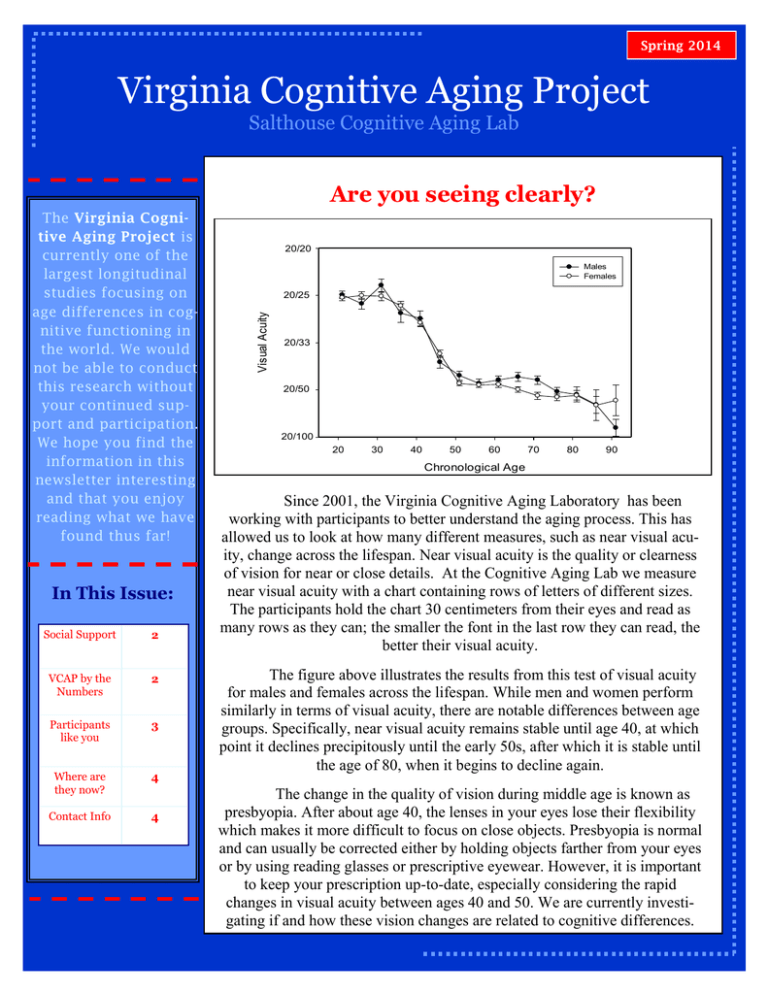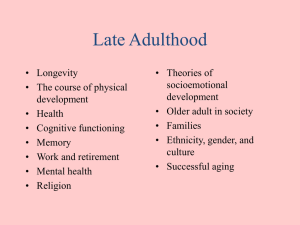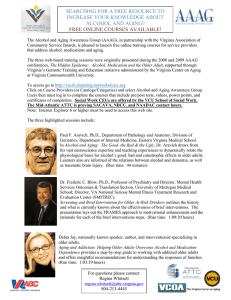Virginia Cognitive Aging Project Are you seeing clearly? Salthouse Cognitive Aging Lab
advertisement

Spring 2014 Virginia Cognitive Aging Project Salthouse Cognitive Aging Lab Are you seeing clearly? In This Issue: Social Support 2 VCAP by the Numbers 2 Participants like you 3 Where are they now? 4 Contact Info 4 20/20 Males Females 20/25 Visual Acuity The Virginia Cognitive Aging Project is currently one of the largest longitudinal studies focusing on age differences in cognitive functioning in the world. We would not be able to conduct this research without your continued support and participation. We hope you find the information in this newsletter interesting and that you enjoy reading what we have found thus far! 20/33 20/50 20/100 20 30 40 50 60 70 80 90 Chronological Age Since 2001, the Virginia Cognitive Aging Laboratory has been working with participants to better understand the aging process. This has allowed us to look at how many different measures, such as near visual acuity, change across the lifespan. Near visual acuity is the quality or clearness of vision for near or close details. At the Cognitive Aging Lab we measure near visual acuity with a chart containing rows of letters of different sizes. The participants hold the chart 30 centimeters from their eyes and read as many rows as they can; the smaller the font in the last row they can read, the better their visual acuity. The figure above illustrates the results from this test of visual acuity for males and females across the lifespan. While men and women perform similarly in terms of visual acuity, there are notable differences between age groups. Specifically, near visual acuity remains stable until age 40, at which point it declines precipitously until the early 50s, after which it is stable until the age of 80, when it begins to decline again. The change in the quality of vision during middle age is known as presbyopia. After about age 40, the lenses in your eyes lose their flexibility which makes it more difficult to focus on close objects. Presbyopia is normal and can usually be corrected either by holding objects farther from your eyes or by using reading glasses or prescriptive eyewear. However, it is important to keep your prescription up-to-date, especially considering the rapid changes in visual acuity between ages 40 and 50. We are currently investigating if and how these vision changes are related to cognitive differences. Page 2 Virginia Cognitive Aging Project Is social support different for males and females? We are beginning to examine the relationships among different measures of social support, which is defined as the aid and assistance received from and given to our family members, friends, and acquaintances. We are also interested in investigating whether different measures of social support vary according to age and gender. 4.0 (Very Often) Males Females 3.5 (Fairly Often) 3.0 One of the strongest differences 2.5 we found was for provided emotional support, which was measured by responses to questions such as: “How often have you (Once in a while) 2.0 been right there with someone who was 20 30 40 50 60 70 80 90 experiencing a stressful situation?” ConChronological Age sistent with previous research, provided emotional support was lower in older participants compared to younger participants, and perhaps not surprisingly, women were more likely than men to provide emotional support in every age group. Because our findings are correlational, there are multiple interpretations of how social support is related to age and sex. For example, aspects of either nature or nurture may contribute to women having a greater tendency to provide emotional support than men. With respect to the age relations, we cannot determine on the basis of our data whether the lower levels of provided emotional support at older ages are attributable to a decrease with age in emotional involvement with others, or to higher prevalence of health issues which makes it more difficult to provide emotional support for others. We hope to be able to distinguish among these interpretations as our research continues, and to investigate if and how aspects of social support are related to cognitive functioning . VCAP by the numbers Over the past 13 years, a total of 4,821 individuals have participated in the Virginia Cognitive Aging Project at least one time. Of that group, over 1,400 have participated on three or more occasions. A handful of people have participated seven times! The longest interval between occasions so far is 12 years, and the longest distance traveled to the lab is over 2,500 miles! (We suspect that this individual participated during a visit to Charlottesville for other purposes and not simply to participate in our project, but we are not ruling out the latter possibility.) All of your hard work certainly adds up. Our research assistants have administered 26,340 one-on-one sessions totaling over 52,680 hours. That’s more than six years of testing! The story of Anna Thompson’s robbery has been tested close to 9,000 times, and each of our research assistants listen to it about 150 times every summer. Our participants range in age from 18 to 99. The most frequent age at the first occasion is 53, and the most frequent occupations include teaching, nursing, and law. Our participants seem to enjoy signing up with friends and loved ones—among our group of participants are approximately 391 couples and 117 families with at least two generations participating in our project. Thank you all for your dedication to the Virginia Cognitive Aging Project...we couldn’t do it without you! Spring 2014 Participants Like You! Page 3 The Sieminski Family Here is what Ginny and Greg Siemenski said when we asked them to tell us a little about themselves and their reasons for participating in the Virginia Cognitive Aging Project: My husband and I signed up to participate in the Cognitive Aging Study when it was first introduced in 2001. We have been contacted several times since then and have enjoyed participating every four to five years. I (Ginny) first found the announcement about this study needing participants. I was a biology major in college. I persuaded my husband to participate to help the cause of science and to earn enough money to go out to dinner with me! My husband and I have always participated on the same date and time. We even travel to the Lab together. Before we reach the Lab, we have a friendly banter about who will do better on the tests and activities. We also "compete" to see who gets out first. My husband is an English major and always knows all of the vocabulary and definitions. I do well on the story and word memory questions. I usually have to ask my husband what a certain word meant on the way home, and he always spouts off a concise and confident definition. Sometimes we will quiz each other on the details of the story we had to memorize or ask each other to list the words we were asked to remember. We usually commiserate about the spatial relation tasks that ask you to fit pieces into a shape, and about the difficulty of the paper folding ones. Our favorite activities in Charlottesville include hiking, visiting historic sites, watching plays and movies and seeing our children in their sporting events. I tease my husband that his full time job is gardening and lawn maintenance, but he earns a paycheck working for the National Ground Intelligence Agency. We had lived in Charlottesville back in the 1980s when my husband was on active duty and worked for what was then the Foreign Science and Technology Center. We fell in love with Charlottesville and hoped to one day return. At the end of my husband's career in the military, we were blessed to be stationed back here in 1999. He retired and began working as a civilian, and we built our dream house and finally threw away the moving boxes after 23 years in the Army. We have five children and have hosted several foreign exchange students and Fellows from our church, so our lives are full of joy. In addition to keeping the house running, I am in my 15th year teaching science to 5th and 6th graders. I also work as a professional face painter - exercising both the left and right sides of my brain! What is the favorite part about being a research assistant at the Cognitive Aging Lab? Being able to meet participants just like you! Here is an inside look at the Sieminski family. Mr. and Mrs. Sieminski have participated with us 4 times since we started in 2001! Where are they now?? received her B.A. in Cognitive Science and Psychology from UVa in Spring 2013. She is currently a first year doctoral student in George Mason University's Human Factors and Applied Cognition program. At GMU, Ari is studying vigilance using Transcranial Doppler Sonography with Dr. Tyler Shaw. graduated from UVa with a B.A. in English and Psychology. She received her Master’s Degree in Secondary English Education at Old Dominion University, and after finishing her student teaching, she spent a few weeks touring Europe. Claudia currently lives in Virginia Beach and teaches 10th and 12th grade English at Kempsville High School. recently graduated from UVa with a B.A. in Psychology and American Studies and plans to pursue a Master’s degree in Speech-Language Pathology. She currently is working as an Associate Director at the Georgetown Learning Center. Her favorite hobbies are singing and acting, and she recently performed in the Heritage Theatre Festival production of Annie Get Your Gun. The Cognitive Aging Lab has employed over 20 research assistants every summer since 2001. Many of our research assistants have been very successful continuing their education or pursuing interesting occupations! In this section we will let you get to know some of our previous research assistants a little more! If you are interested in learning about our current research assistants at the lab, feel free to visit our website at www.mentalaging.com under “Lab Members”. completed her B.A. in psychology and became a professional portrait photographer specializing in children and families. She specializes in custom black and white film-based studio portrait photography. Her subjects range from teeny tiny babies to highpower professionals, to older adults celebrating years of wonderful life. To see examples of her work and more information on portrait sessions, visit catthrasher.com. Cat has continued to work in research, currently collaborating with Vanessa LoBue at Rutgers University on the creation of the Child Affective Facial Expression stimulus set, a photographic representation of children making emotional facial expressions, among other projects. The Virginia Cognitive Aging Project is an ongoing project which is only able to continue because of your participation and support. We will try to contact you in the future , and we hope that you will participate again! Cognitive Aging Lab P.O. Box 400400 We are on the web! www.mentalaging.com Charlottesville, VA 22904-4400 Phone: (434) 982-6320 Email: Cognitive Aging Lab@gmail.com





